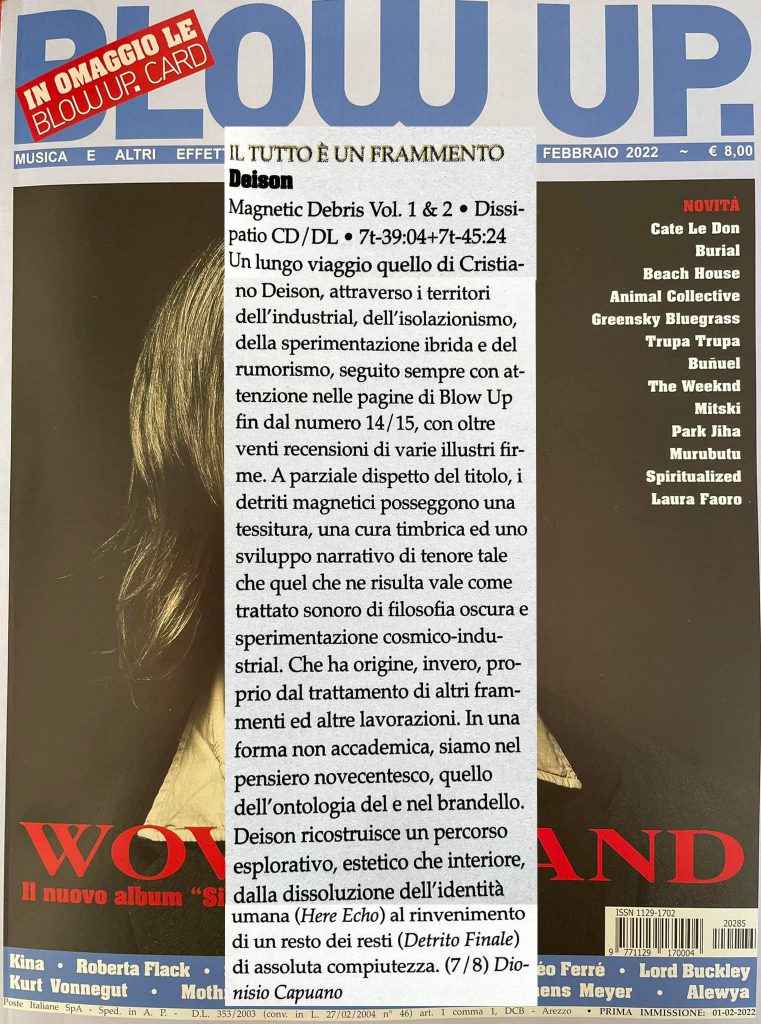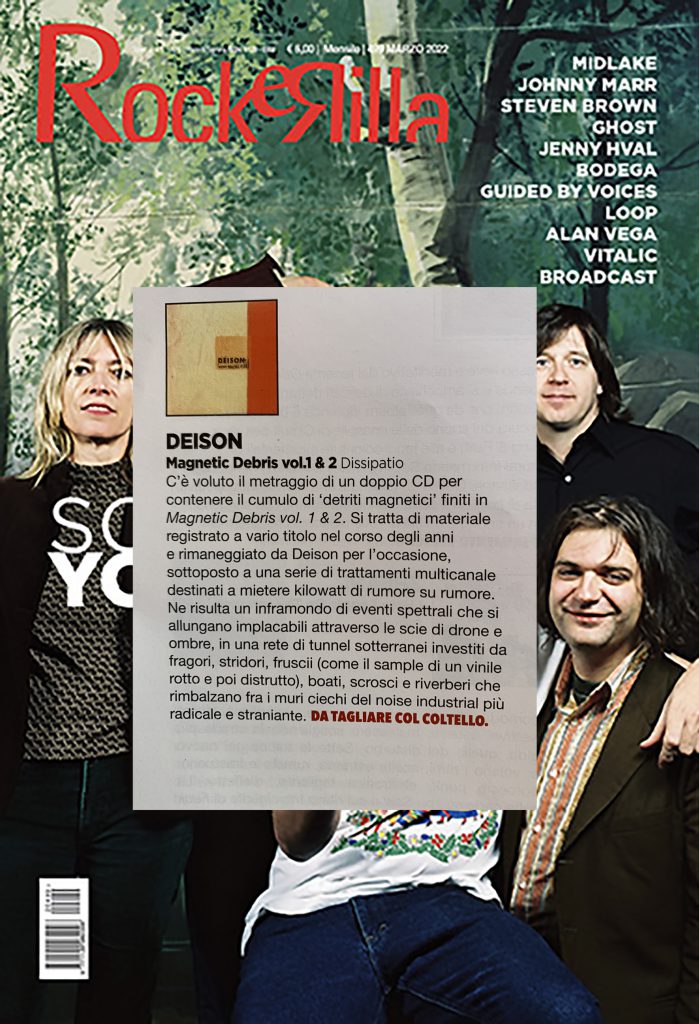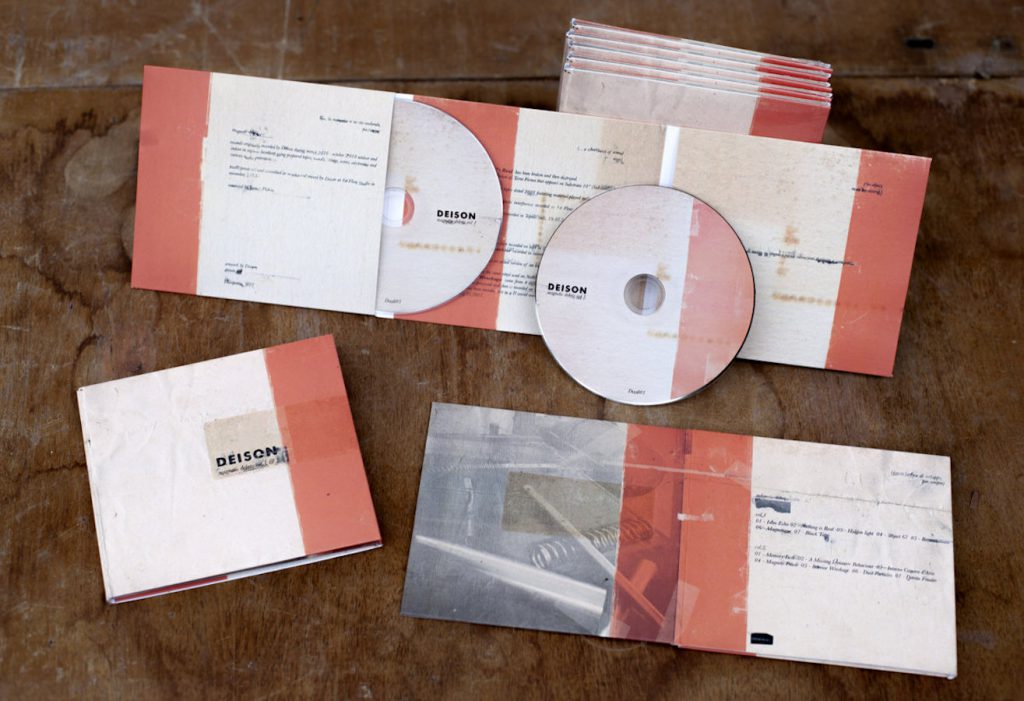DEISON
(2CD, Dissipatio, 2022)
Tracklist
1 Here Echo
2 Nothing Is Real
3 Hidden Light
4 Object 67
5 Reverso
6 Magnetique
7 Black Tape
8 Memory Loss
9 A Missing Dynamic Behaviour
10 Interno Camera d’Aria
11 Magneto Pause
12 Interior Wreckage
13 Dust Particles
14 Detrito Finale
“Magnetic Debris” is a collection of audio works mainly based on the editing of old archived tape loops and “found” magnetic sounds. This material as main reference was subjected to multi-channel treatments, re assembled and mixed along with audio generators, and various electronic devices. These processed debris explores drone territories as a concrete atmospheric soundtrack full of tension with a sense of mystery and a melancholic beauty.
Recorded and assembled in 2018, this double album has been mastered by James Plotkin.
MAGNETIC DEBRIS RECENSIONE DI VITTORE BARONI
Nel nuovo doppio CD “Magnetic Debris Vol. 1 & 2” (Dissipatio) Cristiano Deison raccoglie una selezione di “detriti” di qualità, rivisitando e rielaborando materiali d’archivio che risalgono fino al 1997, in un viaggio nella memoria che fa il punto sull’esperienza affinata dall’autore in diverse aree sonore negli ultimi trent’anni. Si parte nel CD 1 da territori propri a Philip Jeck (puntine che saltano, vinili scricchiolanti, glitch vintage) presto addizionati a dark ambient di lusmordiana potenza, profonde scosse sotterranee ma anche geometrie di acuti suoni cristallini, spigolose composizioni basate su trattamenti di suoni originati da oggetti e lastre metalliche come pure (quasi) rasserenante drone ambient notturna, integrando l’altero distacco e la precisione millimetrica di progressioni memori di maestri dell’elettronica contemporanea “colta” con l’energia dinamica di chi è cresciuto anche con passioni extra-colte industrial-noise-metal. Un gran bel lavoro insomma, in parte ricapitolativo, di cui ringrazio l’amico Nicola Quiriconi sempre più attivo con la sua etichetta Dissipatio.
MAGNETIC DEBRIS SU VER SACRUM
Deison è uno storico sperimentatore musicale italiano (nato a Udine nel 1971) da più di 25 anni. Ha un approccio particolare alla materia sonora che lo ha portato a sperimentare dei bizzarri collages registrati su cassetta. Ha alle spalle collaborazioni di prestigio con artisti come Lasse Marhaug, KK Null, Teho Teardo, Thurston Moore, John Duncan ed altri. Ma ha unito le energie anche con nomi della scena sperimentale italiana fra cui Maurizio Bianchi, Gianluca Becuzzi, Simon Balestrazzi e Gianluca Favaron. Il suo nuovo doppio cd, appena uscito per la Dissipatio ed intitolato Magnetic Debris, è una collezione di vecchio materiale che viene qui rimodellato e plasmato dandogli una nuova veste estetica. Il risultato finale suona molto d’atmosfera che dona un tocco di mistero all’insieme. Il disco è stato assemblato durante il 2018 e masterizzato da James Plotkin. Alcune tracce sono veramente particolari come “Nothing Is Real” dove è stato usato un vinile rotto che è stato poi distrutto. In “Reverso” possiamo invece ascoltare il suono di oggetti di metallo. Anche nel secondo dischetto troviamo molte sorprese: in “Magneto Pausa” viene usato lo stesso vinile di “Nothing Is Real” mentre “Interior of Wreckage” contiene il suono processato e riprocessato di 4 differenti cassette. Ma forse la traccia più affascinante di Magnetic Debris è “Dust Particles” in quanto è stata registrata dal vivo all’interno di un bunker della seconda guerra mondiale. La musica di “Dust Particles” sarebbe piaciuta di sicuro allo scrittore di fantascienza James Graham Ballard che, in La mostra delle atrocità ha dedicato parole ispirate per descrivere i bunker nazisti del Vallo atlantico definiti “Cattedrali dell’era spaziale” che “Sembrano contenere i codici di qualche misterioso processo mentale”. Siamo di fronte ad un album che verrà apprezzato da quello zoccolo durissimo che ama la ricerca e la musica drone. (LINK)
MAGNETIC DEBRIS ON VITAL WEEKLY
Ah! Am I correct to assume that Deison is a household name on these pages by now? Over the years, I reviewed quite a bit of his work, going from strength to strength. On this new release, Italian musician Deison delves into his archives, which are no doubt vast, and on these CDs, we don’t find finished pieces from the old tapes, but rather blocks of old sounds, being re-used, re-mixed, re-configurated into new music. Multi-channel pieces are torn apart, and sounds are used for something new. Some of these pieces use sound from 1997, from old four-track tapes, but also recordings of magnetic interference. Liner notes such as these make an interesting read, especially when it’s like this: “Memory Loss contains a piano loop recorded on tape in 1997”. You play the piece and don’t recognize any piano. I love stuff like that. The first CD is forty minutes, the second forty-six, so it could all fit on one disc with a bit of editing, but who am I to complain?
Deison’s music can be classified as working with dark space, a black hole if you will. Each of the fourteen pieces is a variation of shimmering darkness. Be it a computerized, granulated drone, or heavily treated field recordings (or not? “Interno Camera d’Aria is an edited version of an indefinable unreleased impro track created in 2006”) or percussion and guitars being slowed down ad Infinitum. The latter instrument seems to play a bigger role on the first disc than on the second. It also seems that the first disc has some louder music, when Deison covers musical ground covered by early Organum. Sound sources include “broken and then destroyed vinyl” (which made me scratch my head), which still sounds like vinyl. Everything sounds like nuclear dust covers and obscures the proceedings, but it’s that ash grey quality that fits the cold winter’s day perfectly (as long, of course, as you can stay inside and listen to the soundtrack; you shouldn’t suffer cold weather). Please don’t think there is any variation here. ‘Hidden Light’, with its higher piercing drones, sounds completely different from the non-moving ‘Dust Particles’. Parameters shift and move, and it delivers some great music. (FdW) (LINK)
MAGNETIC DEBRIS ON BORING LIKE A DRILL
While almost all of our musical experience is now electronically mediated, we still think of it as a primarily acoustic, organic event: the presence of electronics in music still extends to us the expectation that something will be done to make things new. Where electronics predominate, it implies something outside of the human experience – possibly transcendental (new age), ecstatic (techno), cathartic (noise) or a kind of negative dialectic of entertainment (industrial). As a genre, industrial music has typically become more post-industrial, revelling in entropy and decay in a sort of romantic or nihilistic (same diff) reverie. Deison’s Magnetic Debris vol. 1 & 2 isn’t industrial, but it does make that common use of decayed tech, a romance of ruins. The fourteen tracks are composed mostly from old media and found sounds: aged cassettes, broken records and elettromagnetic interference. At first, the resulting pieces seemed inert, smoothing away the interesting details that may be found in the material. On repeated listening, however, each piece revealed a compositional depth and character that showed Magnetic Debris was not an exercise in documentation, but a restrictive means to an end in producing music that rewards subjective consideration. (LINK)
MAGNETIC DEBRIS SU BLOW UP

MAGNETIC DEBRIS SU ROCKERILLA



